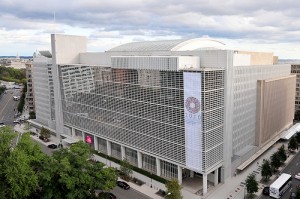The World Bank's Chance To Clean Up Its Coal Act
 Coal kills. Don’t take it from us; that’s what International Monetary Fund chief Christine Lagarde told a Washington, D.C., audience recently, noting that coal pollution is responsible for 70,000 premature deaths each year in India alone. Shockingly, that is only the tip of the iceberg. Even in developed countries like the United States, coal burning is responsible for approximately 13,200 deaths, 9,700 hospitalizations, and more than 20,000 heart attacks annually.
Coal kills. Don’t take it from us; that’s what International Monetary Fund chief Christine Lagarde told a Washington, D.C., audience recently, noting that coal pollution is responsible for 70,000 premature deaths each year in India alone. Shockingly, that is only the tip of the iceberg. Even in developed countries like the United States, coal burning is responsible for approximately 13,200 deaths, 9,700 hospitalizations, and more than 20,000 heart attacks annually.Even though this public health catastrophe is entirely avoidable, coal plants are still being built around the world — even though clean energy can be brought online more cheaply. We have an opportunity to make international coal development a relic of the past, and one man is in the unique position to do this: the World Bank’s new president, Dr. Jim Yong Kim.
No one understands the trade-offs between development and public health better than Dr. Kim. He is a lifelong health advocate who cofounded the influential group Partners in Health, and he has tackled the issue head-on in his book, Dying for Growth. He contends that when “the imperatives of growth at any cost increasingly determine economic and social policy and the behavior of global corporations, more people join the ranks of the poor and greater numbers suffer and die.” This simple but profound statement underscores why people in villages across India are standing up, fighting back, and even dying to beat back coal pollution.
Thus far, the World Bank has erred on the side of growth at any cost. But we now know the true medical and public health consequences of dirty coal plants. We also know that technology available today can dramatically reduce toxic pollution from coal plants — including carbon monoxide, particulate matter, mercury, arsenic, lead and cadmium. The World Bank has not even required the coal plants it funds to use this technology, ostensibly because it wants to keep costs down and power cheap.
Dr. Kim can work with the World Bank’s board to shape policy that better takes into account our current understanding of the threat that coal-burning poses to the health and well-being of all the people on this planet. He can advocate for an end to massive investment in new, uncontrolled coal-fired power plants around the world.
One such project in India, the enormous Tata Mundra plant, which is about the size of eight typical U.S. coal plants, is located just 1,500 feet from an even larger coal plant — and neither plant has any pollution-control equipment for deadly fine-particulate pollutants. Despite fierce resistance from activists like Bharat Patel, the World Bank continues to bankroll the project. And Tata Mundra is now seeking a government bailout (paid for by India’s people) because, despite Tata Power’s claims to the contrary, coal is no longer an inexpensive form of electricity.
To make matters worse, the World Bank is now considering an even more egregious affront to public health — a brand new strip mine for lignite (the dirtiest type of coal) and a coal-burning power plant for the war-torn country of Kosovo, which lacks modern pollution-control equipment. And the World Bank is pushing ahead, despite growing agitation from the people of Kosovo for “No New Coal).
The environmental and public health communities have taken up this call to roll back these threats to our health. Here in the United States, we have been beating back the coal industry and its assault on public health by demanding that old, dirty coal plants be either cleaned up or retired. To date we have stopped 169 new coal plants from coming on line and have helped secure the retirement of 112 dirty coal plants — paving the way for a job-creating, clean-energy future based on wind, solar and energy-efficiency. Coal has been polluting our air and water with impunity for far too long, but in the United States, those days are over.
This should be a new dawn at the World Bank. Dr. Kim’s presidency is only in its first week, but we are confident that change is in the wind. Dr. Kim is both a champion for public health, and a long-time friend of the developing world. Past World Bank leaders have put development for development’s sake ahead of the health and well-being of the very people it was supposed to benefit. We know Dr. Kim is not a part of this crowd. Today we align our hopes and dreams with communities across the world that are fighting death, disease, and displacement from this dangerous industry, and we look forward to Dr. Kim ushering in a new era at the World Bank — free from coal’s deadly legacy.
You can return to the main Market News page, or press the Back button on your browser.

